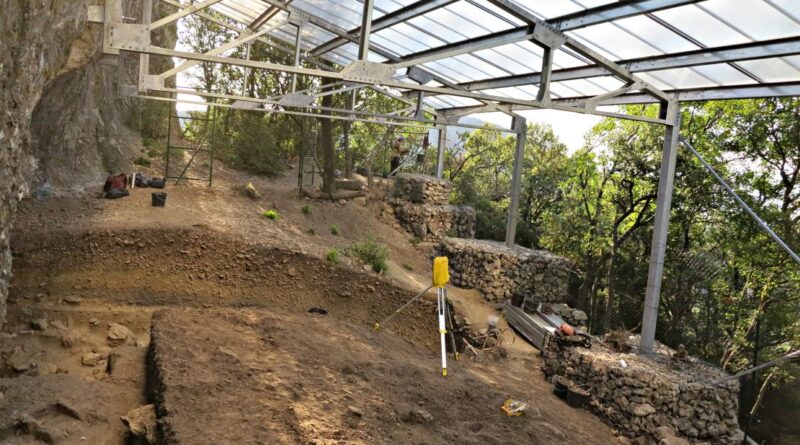Cave discovery may explain why Neanderthals disappeared, scientists say | CNN
Sign up for CNN’s Wonder Theory science newsletter. Explore the universe with news about fascinating discoveries, scientific advances and more.
CNN
–
When archaeologist Ludovic Slimak unearthed five teeth from a rock shelter in France’s Rhône Valley in 2015, it was immediately obvious that they belonged to Neanderthals, the first fossils of an ancient species. discovered in the country since 1979.
However, the first real-life discovery, named Thorin after the character in “The Hobbit,” remained a well-kept secret for nearly a decade when Slimak and co-‘ They are also erasing the value of what was found – hard work that went to waste. ancient DNA experts versus archaeologists.
Slimak, a researcher at France’s National Institute for Scientific Research and Paul Sabatier University in Toulouse said: “We faced a big problem. “The genetics confirmed that the Neanderthal we named Thorin was 105,000 years old. But we knew from (the paleontology sample) that he was between 40,000 and 50,000 years old. .”
“What the DNA suggested was inconsistent with what we saw,” he added.
It took the team nearly 10 years to piece together the mysterious Neanderthal story, adding a new chapter to the age-old mystery of why these people disappeared 40,000 years ago.
The research, published Wednesday in the journal Cell Genomics, found that Thorin belonged to a lineage or group of Neanderthals that had been separated from other groups for about 50,000 years. This genetic separation is the reason why Thorin’s DNA appeared to come from an earlier time than it actually did.
Until now, geneticists thought that there were Neanderthal populations at the time of the extinction, but a new study reveals that at least two populations were present. Western Europe at that time – and they lived surprisingly close to each other.
“Thorin’s population went 50,000 years without exchanging genes with other Neanderthal populations,” Slimak said in a press release.
So we have 50 thousand years in which two Neanderthals, who lived about ten days apart from each other, lived together but completely ignored each other.
Slimak said the discovery suggests that Neanderthal communities were small and disjointed — facts that could be important to understanding their extinction because isolation is considered a barrier to evolution.
Limited genetic diversity can make it difficult to adapt to changing climates or diseases, while limited social interaction between groups makes it difficult to share knowledge and technology.
“They were happy in their valley and they didn’t need to move, while Homo sapiens always wanted to explore, to see what was behind this river, behind this mountain . (We have) this need, this need to migrate, and this need to create a social network,” Slimak said.
He said that this form of small people, separated culturally and genetically from others, is probably the main reason for the extinction of Neanderthals, which happened at the same time that Homo sapiens arrived in Europe.
DNA from the remains of Homo sapiens from that time shows that these early arrivals mixed with Neanderthals – traces of those events are still present in modern humans. However, no genetic evidence of interbreeding has been found in Neanderthal remains since then, including Thorin’s remains, the study noted.
Whatever behavior caused this lack of genetic overlap on one side, as well as fewer Neanderthals such as those identified by Slimak and his colleagues, may have contributed to extinction of the Neanderthals, said Chris Stringer, who leads the study of human evolution in London. Natural History Museum who were not involved in the study.
“Whatever the reasons for this imbalance (social, biological?) contributed to the extinction of the last Neanderthals, as their already young population was losing are people of reproductive age in other species, without being replenished,” Stringer said by email.
“Combined with economic competition from newcomers for resources, this would have been the cause of the population collapse.”
It is unclear whether Thorin’s complete skeleton is interred in the Grotte Mandrin, as the rock shelter in the Rhône Valley near Malataverne, France, is known. The remains were found near the surface in soft, unstable soil, and the excavation is proceeding slowly, Slimak said, with archaeologists removing “one grain at a time.” .” It is also not clear whether the model, which is male, was intentionally hidden or not.
Archaeologists have unearthed many of Thorin’s remains: 31 teeth, part of a jaw and five finger bones, so far. The shape of his teeth is similar to a Neanderthal, but he had two lower molars – a feature that sometimes gives the impression of inbred people, the study noted.
Early genetic analysis suggested that Thorin was very large because his genome was different from that of other modern Neanderthals, which resemble the genomes of large humans. -those who lived more than 100,000 years ago..
In order to understand Thorin’s origins and confirm the age of his remains, the team analyzed chemical isotopes in his bones and teeth to determine what type of climate he lived in. according to the water he would drink and other details. A European Neanderthal 105,000 years ago would have enjoyed a warmer climate than those who lived 45,000 years ago during the Ice Age.
“We worked for seven years to find out who was wrong – the archaeologists or the genomicists,” Slimak said in a press release.
Slimak has been involved in the excavations of Grotte Mandrin for more than thirty years and has found many interesting things in the stone area. It is the only place known to have been home to intermingling groups of Homo sapiens and Neanderthals, as well as the oldest evidence of bow and arrow use outside of Africa.
“Grotte Mandrin always delivers surprises,” Stringer said.
#Cave #discovery #explain #Neanderthals #disappeared #scientists #CNN
